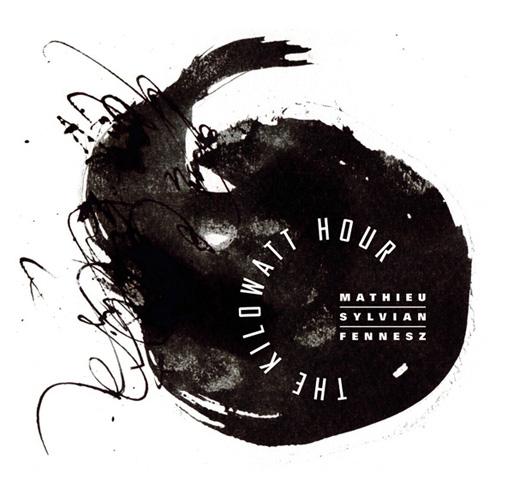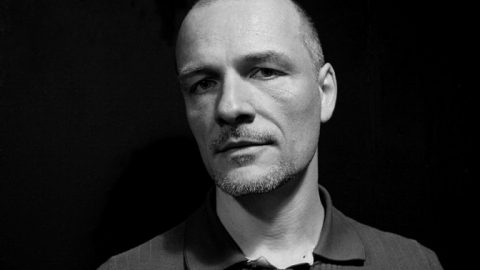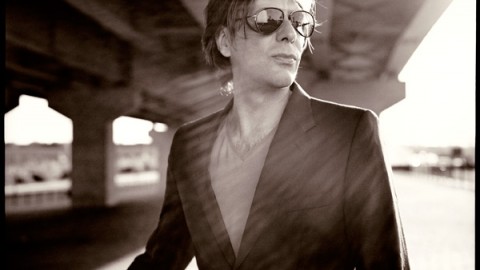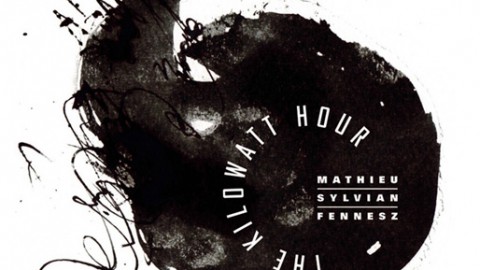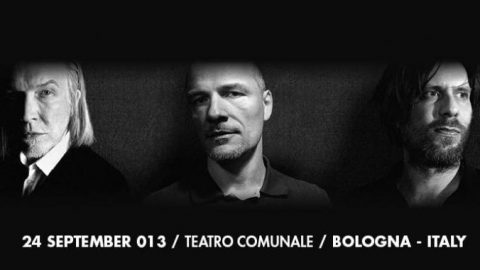September 22, 2013
The Kilowatt Hour, a trio formed by Stephan Mathieu, Christian Fennesz and David Sylvian started at the Punkt Festival 2013 with a 72 minute performance with poems by- and narated by the American poet Franz Wright. A small tour followed.
Christian Fennesz and David Sylvian first collaborated on albums such as ‘Blemish’, ‘Venice’, and ‘Manafon’, and following the recent collaboration between Stephan Mathieu and Sylvian on ‘Wandermüde’, comes a new project, The Kilowatt Hour, a trio formed by Mathieu, Sylvian and Fennesz.
Whilst currently a vehicle for touring improvised instrumental works there are no limitations set on where this initial exploration might lead. This debut series of concerts will reveal a work in progress, a continued exploration of the chemistry shared between these very unique artists.
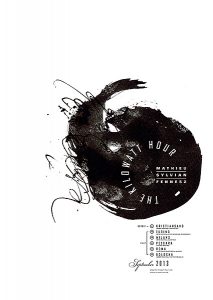 Kilowatt Hour by Chris BiggThe Kilowatt Hour, a new collaborative trio featuring Stephan Mathieu, David Sylvian and Christian Fennesz, has just announced a set of live dates in Europe this fall. The instrumental trio will develop material this summer to debut at the Punkt Festival in Kristiansand, Norway on September 7, followed by a series of dates in Italy.
Kilowatt Hour by Chris BiggThe Kilowatt Hour, a new collaborative trio featuring Stephan Mathieu, David Sylvian and Christian Fennesz, has just announced a set of live dates in Europe this fall. The instrumental trio will develop material this summer to debut at the Punkt Festival in Kristiansand, Norway on September 7, followed by a series of dates in Italy.
Says Sylvian, “I feel very fortunate to be in the company of two musicians whom I’ve great respect for and whose generosity and companionship have enriched my personal and working life. We’re going to undertake a brief excursion together to see where it might lead. There’s no complacency, no shortcuts being taken. We’re looking to create something unique and exciting for ourselves and a fresh experience for those that attend the performances.”
The January release of Mathieu and Sylvian’s Wandermüde marked the first time these musicians came together, albeit from a distance: Mathieu built the album with material from Sylvian’s 2003 masterpiece Blemish, remixing and reinterpreting it using his practice of live processing. Fennesz makes a cameo via a guitar solo that appears on the final track, “Deceleration.” Like a heart caught in mid-beat, this ambient work has a stillness that never becomes stale, and a warmth that never embraces you. It indicates the sensibilities of all three men, but they’re quick to point out that this is just one guidepost to where the trio will lead: they will be meeting in Vienna this July to work on material, and all ideas are on the table.
“A basic guide for our performance is the idea of ‘eventlessness,’” says Mathieu. “Right now we aim at creating a composition which is fixed to a certain degree but leaves enough space to shape in a live situation. So, while we will present a piece, this will vary slightly from show to show.”
“I’d like to find material through improvisation,” says Fennesz. “It definitely is a risky project but that makes it exciting. It’s a bit like jumping into cold water.”
The Kilowatt Hour is the first collaboration between Fennesz and Mathieu, who have known each other since the ‘90s. The Austrian guitarist and German electroacoustic musician and producer both work in the broad fields of electronic and improvised music. Fennesz, best known for shimmering pop albums including Endless Summer, has also performed in exquisite free improv sessions with fellow luminaries like Keith Rowe and Toshimaru Nakamura. Stephan Mathieu, who began his career as a drummer, is a sound artist working loosely in two veins: the live processing of digital sources, and projects built on acoustic sources such as historical instruments and mechanical gramophones. His albums include the acclaimed 2008 release Radioland, and his upcoming The Falling Rocket.
David Sylvian has worked with both men over the last decade, and the trio will also mark a return to the ambient experiments that he has pursued on and off since the ‘80s, notably on Plight and Premonition and Flux and Mutability, his two albums with Can’s Holger Czukay. “The pieces I created with Holger were works that evolved very naturally without any recourse to the standard notion of ‘performance’ per se. What was captured was the tentative, the unsure footing, the meandering evolution of an idea before it became solidified in the mind, subject to the process of self-editing, practice and performance in the sense of something learned by rote and repeated with emotional emphasis. We obliterated the performative element wherever it threatened to creep into the improvisations. If I carry anything over from past projects maybe it’d be this practice.”
For Sylvian, the project entails taking risks: he will forego his most familiar instrument – his voice – and he will be returning to the stage for the first time since his 2007 tour. “What will actually transpire once we’re in a room together might be grounded in these early developments or something other might result from them and/or the chemistry between us,” says Sylvian. “Both Stephan and Christian have systems in place that they’re very familiar with. In this respect I’m something of an outsider as I’ve avoided working with specific set-ups most of my life. Each new project involves a learning curve, a process of starting over. I’m curious as to what my response will be to Christian and Stephan’s intimacy and fluency with their set-ups. If I’m honest I’d be disappointed if I failed to discover a new language with which to work.”
With no rules to restrict them and no plan beyond these concerts, the Kilowatt Hour venture out with nothing but their intuition and taste to guide them. The performances will be an adventure for audience and artists alike.
Review Susanna Buffa at Shuffle Mag
ROMA, 22 Settembre 2013 -:- AUDITORIUM PARCO DELLA MUSICA
E tra gli appuntamenti pi attesi della stagione autunnale 2013 e vede tre esponenti illustri della sperimentazione musicale attuale, Stephan Mathieu, David Sylvian e Christian Fennesz, occupare il palco dietro sofisticate postazioni elettroniche. Alle loro spalle, tre megascreen fanno ruotare immagini fluttuanti e rarefatte. I tre artisti, sulla base di collaborazioni pregresse consolidate, hanno creato un progetto davvero affascinante in cui lÂuniverso sonoro prodotto dalle esperienze individuali e comuni resta inscindibile dall’arte visuale.
Questo insieme molto compatto di suoni rarefatti e inafferrabili prodotto da una strumentazione articolata David Sylvian: piano e laptop; Christian Fennesz: chitarra, pedali, laptop; Stephan Mathieu: zither, e-bow, laptop, mixer. Labili ma presenti i riferimenti armonici dei tre musicisti, che operano in un buio totale e avvolgente, apparentemente ignorandosi e in realt’ dando prova di un interplay consolidato, a dispetto delle poche prove effettuate prima del tour.
La voce umana si inserisce in questo universo di suoni impalpabili quasi esclusivamente attraverso degli spoken registrati ‘ e qui ‘ inevitabile il rimando al passato: dallo spoken della prima traccia della sezione strumentale di ‘Gone To Earth’ alle successive collaborazioni di Sylvian con sperimentatori e sound designer del calibro di Holger Czukay.
Autocitazioni e derivazioni a parte, la novit’ del progetto risiede nella profonda riflessione sull’esperienza terrena dell’essere umano, resa con suoni e fasci di luce. Un racconto, una narrazione sonora con una drammaturgia che si rivela solo nella conclusione.
Viene inclusa in questo discorso sonoro e visuale la celebrazione della natura, evocata visivamente e verbalmente campi di mais, gabbiani, cielo e protagonista di un godimento immediato e circoscritto al tempo presente, quello del piacere unico vissuto nel momento transitorio e fugace.
La suggestiva evocazione del mondo naturale disturbata da suoni di fascia acuta prodotti artificialmente (opera della geniale mente di Mathieu), mentre la cadenza ritmica di questa massa sonora e visuale, essenzialmente affidata a Fennesz, bench impercettibile viva e pulsante; qualcosa che ha a che fare col movimento delle stelle e dei pianeti, con le fasi lunari, con il ritmo vitale dell’universo.
Le parti improvvisate di piano e chitarra, che si innestano su un tappeto precostituito di suoni sintetici, non sono che l’introduzione ad una nuova elaborazione visual, ipnotica e concreta, della tessitura sonora. E il momento dellÂincontro di due ambiti opposti: l’uno espressione del respiro dell’anima ed un insieme di suoni acustici e campionati, l’altro costituito da suoni distorti o generati artificialmente, rumori, riproduzioni di vibrazioni elettromagnetiche su cui rientra la voce narrante mentre gli schermi rimandano l’immagine della perfezione simmetrica di forme sferiche che fluttuano su uno sfondo scuro, magmatico.
I fili di questa trama si compattano poi per innalzare un muro di suono potente e invalicabile, seguiti da una conclusione che include persino il campionamento di archi schubertiani e che accompagna la parte finale della narrazione, il punto di arrivo della storia, la fine della parabola: la morte.
The Kilowatt Hour una performance che si caratterizza anche per la sua brevit il che senz’altro una qualit , data lintensit delle emozioni suscitate. Eppure pu essere letta come la narrazione della storia di un essere umano: l’arco di una vita condensato in poco pi di un’ora.
E’ come suonano le nostre vite oggi, nel 2013, che ci piaccia o no.
Susanna Buffa

